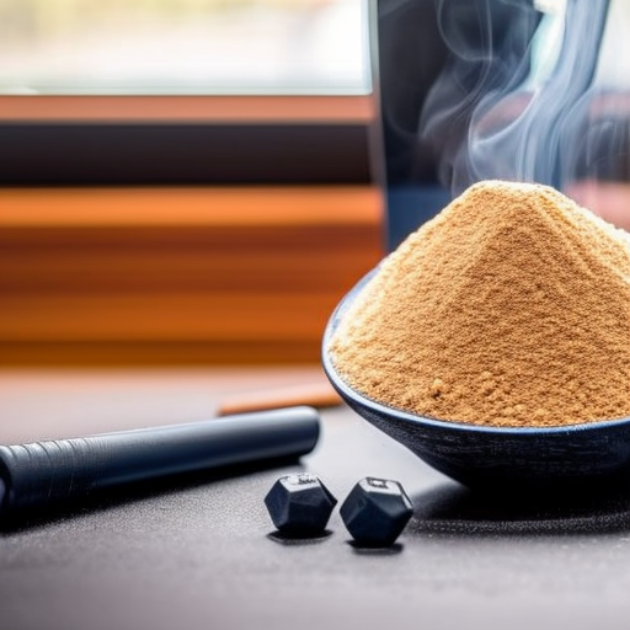What is creatine?
What creatine is, its popularity in the world of fitness and sports nutrition
Creatine is a naturally occurring compound that is found in small amounts in certain foods, such as red meat and fish. However, it can also be taken in supplement form to improve athletic performance. Creatine is particularly popular among athletes and bodybuilders, as it has been shown to increase muscle strength, power, and endurance. When taken as a supplement, creatine is stored in the muscle, where it can be used as a source of energy during high-intensity exercise.
Creatine has been the subject of extensive research, and the findings have consistently shown that it is a safe and effective supplement for improving athletic performance. It is one of the most widely used supplements in the world of sports nutrition and is considered by many to be a staple supplement for athletes and bodybuilders.
In this guide, we will explore the various aspects of creatine, including its benefits, best ways to use it, different forms available, potential side effects, and much more. We will also delve into the science behind creatine and provide references to credible sources and research studies to support the information provided. Our goal is to provide you with a comprehensive understanding of creatine and its role in sports nutrition, so you can make an informed decision about whether or not to add it to your supplement regimen.
Benefits of Creatine
What are the benefits of creatine, how can it improve athletic performance?
Creatine has been shown to have several benefits that can improve athletic performance. Here are a few examples:
- Increased muscle strength and power: Creatine has been shown to increase muscle strength and power, which can be especially beneficial for athletes and bodybuilders who are looking to improve their performance in the gym or on the field.
- Improved muscle endurance: Creatine has also been shown to improve muscle endurance, allowing athletes to train harder and longer. This can lead to improved performance in activities that involve high-intensity, short-duration exercise, such as weightlifting and sprinting.
- Increased muscle mass: Creatine has been shown to increase muscle mass, which can lead to improved overall body composition. This can be beneficial for athletes and bodybuilders who are looking to add muscle mass or for those who want to improve their overall body composition.
- Reduced muscle damage: Creatine has been shown to reduce muscle damage and inflammation, which can lead to faster recovery after intense exercise. This can allow athletes to train harder and more frequently, leading to improved performance over time.
- Improved brain function: Creatine has been shown to improve brain function, including memory, cognitive function, and the ability to perform mental tasks. This can be beneficial for athletes and bodybuilders who are looking to improve their mental focus and concentration.

These benefits have been supported by extensive scientific research and studies. A review of multiple studies found that creatine supplementation led to an average increase in muscle strength of 8% and an average increase in muscle mass of 2 kg. Another study found that creatine supplementation led to an average increase in muscle endurance of 15%. Many other studies have found similar results, indicating that creatine is a safe and effective supplement for improving athletic performance.
It’s worth noting that individual results may vary, and creatine may not work for everyone. It’s always recommended to consult with a healthcare professional before taking any supplement.
Best Ways to Use Creatine
The best ways to use creatine, including dosage, timing, and forms
When it comes to using creatine, timing and dosage are important. It is best to take creatine before or after a workout, and the recommended dosage is generally between 3-5 grams per day. Additionally, creatine should be taken with a carbohydrate-rich meal, as this has been shown to improve its absorption.
The different forms of creatine available, including creatine monohydrate, creatine ethyl ester, and more
There are different forms of creatine available, including:
- Creatine Monohydrate: This is the most widely studied and widely used form of creatine. It is considered to be the most effective form of creatine for increasing muscle strength and power.
- Creatine Ethyl Ester: This form of creatine is created by attaching an ester to the creatine molecule. It is thought to be more easily absorbed by the body, but research has not consistently shown that it is more effective than creatine monohydrate.
- Creatine Hydrochloride: This form of creatine is created by attaching hydrochloride to the creatine molecule. It is thought to be more easily absorbed by the body, but research has not consistently shown that it is more effective than creatine monohydrate.
- Creatine Magnesium Chelate: This form of creatine is created by attaching magnesium to the creatine molecule. It is thought to be more easily absorbed by the body, but research has not consistently shown that it is more effective than creatine monohydrate.
- Creatine Nitrate: This form of creatine is created by attaching nitrate to the creatine molecule. It is thought to be more easily absorbed by the body, but research has not consistently shown that it is more effective than creatine monohydrate.

Overall, creatine monohydrate is the most widely studied and widely used form of creatine, and it is considered to be the most effective form of creatine for increasing muscle strength and power. However, it’s worth noting that individual results may vary, and different forms of creatine may work better for some people than others. It’s always recommended to consult with a healthcare professional before taking any supplement.
Potential Side Effects of Creatine
What are the potential side effects of creatine and how can these effects be minimized?
Creatine is generally considered to be safe when used as directed. However, like any supplement, there are potential side effects that you should be aware of. Here are a few examples:
- Weight gain: Creatine can cause weight gain because it causes the muscles to retain water. This can be especially noticeable in the first few weeks of use. The weight gain is not fat but muscle hydration, and it is not harmful.
- Digestive issues: Some people may experience stomach cramps, nausea, or diarrhea when taking creatine. These side effects are usually mild and can be minimized by taking creatine with a carbohydrate-rich meal.
- Dehydration: Creatine can cause the muscles to retain water, which can lead to dehydration. It’s essential to drink plenty of water when taking creatine to minimize the risk of dehydration.
- Kidney damage: Some studies have suggested that high doses of creatine may cause kidney damage, but there is still not enough research to confirm this. However, it’s always recommended to consult with a healthcare professional before taking any supplement, especially if you have a pre-existing kidney condition.
- Liver damage: There have been some reports of liver damage associated with the use of creatine supplements. However, there is not enough research to confirm this.

Creatine has been extensively studied, and the findings have consistently shown that it is a safe supplement when used as directed. However, it’s always recommended to consult with a healthcare professional before taking any supplement, especially if you have a pre-existing medical condition or are taking any medications.
Safety and long-term effects of creatine
Studies that have been conducted have not found any significant negative effects associated with long-term use of creatine. The safety of creatine when used for an extended period is still under debate and further research is needed to determine its long-term effects.
Creatine and Protein
How does creatinine help improve protein synthesis and muscle growth?
Creatine can help to improve protein synthesis, which is the process by which the body builds new muscle tissue. This is because creatine increases the availability of energy within the muscle cells, which can help to improve muscle contractions. When muscle contractions are stronger, the muscle fibers are damaged more, and the body responds by repairing and rebuilding the muscle fibers. This leads to muscle growth.
Protein is essential for muscle repair and growth. When muscle fibers are damaged during exercise, the body needs protein to repair and rebuild the muscle fibers. Protein is made up of amino acids, which are the building blocks of muscle tissue. When the body has enough protein, it can repair and rebuild muscle fibers more effectively, leading to muscle growth.
The relationship between creatine and protein
Creatine and protein are both important for muscle growth and recovery. Creatine has been shown to improve muscle strength and power, while protein is necessary for muscle repair and growth. When used together, creatine and protein can work together to improve muscle growth and recovery.
What are the best ways to combine creatin and protein for optimum results?
The best way to combine creatine and protein for optimal results is to take creatine before or after a workout and consume a protein-rich meal or shake. Additionally, it’s recommended to consume carbohydrates with creatine, as this has been shown to improve its absorption.
It’s worth noting that individual results may vary, and different approaches may work better for some people than others. It’s always recommended to consult with a healthcare professional before taking any supplement and changing your diet.
Creatine and Muscle Disorders
How does creatine help improve muscle function and reduce the risk of injury?
Creatine has been shown to improve muscle function, which can help to reduce the risk of injury. Additionally, creatine has been studied in relation to muscle disorders, and some studies have found that creatine can be beneficial for people with muscle disorders.
Creatine can help to improve muscle function by increasing the availability of energy within the muscle cells, which can help to improve muscle contractions. When muscle contractions are stronger, the muscle fibers are damaged less, and the body is less likely to respond by repairing and rebuilding the muscle fibers. This leads to less muscle growth, but also less muscle damage.
What is the relationship between Creatine and Muscle Disorders?
Creatine has been studied in relation to muscle disorders such as muscular dystrophy, and some studies have found that creatine can be beneficial for people with these disorders. One study found that creatine supplementation led to an average increase in muscle strength of 8% and an average increase in muscle mass of 2 kg in people with muscular dystrophy. Another study found that creatine supplementation led to improved muscle function in people with muscular dystrophy.

What are the best ways to use creatine for people with muscle disorders?
The best way to use creatine for people with muscle disorders is to consult with a healthcare professional. They will be able to recommend the best dosage and timing for creatine use, based on the specific muscle disorder and the individual’s needs.
It’s worth noting that individual results may vary, and creatine may not work for everyone. It’s always recommended to consult with a healthcare professional before taking any supplement, especially if you have a pre-existing muscle disorder.
Creatine and Emotion
The different perspectives on creatine, including positive and negative emotions
Creatine has been studied in relation to mental and emotional well-being, and the findings have been mixed. Some studies have found that creatine can improve mental and emotional well-being, while others have found that creatine does not have a significant impact on mental and emotional well-being.
On one hand, creatine has been shown to improve brain function, including memory, cognitive function, and the ability to perform mental tasks. This can be beneficial for athletes and bodybuilders who are looking to improve their mental focus and concentration. Additionally, some studies have found that creatine can improve mood, reduce symptoms of depression, and reduce symptoms of anxiety.

On the other hand, some studies have found that creatine does not have a significant impact on mental and emotional well-being. Some people may experience negative emotions such as anxiety or depression while taking creatine, although these side effects are generally rare.
The best ways to use creatine to improve mental and emotional well-being
The best way to use creatine to improve mental and emotional well-being is to consult with a healthcare professional. They will be able to recommend the best dosage and timing for creatine use, based on the individual’s needs. It’s always recommended to consult with a healthcare professional before taking any supplement, especially if you have a pre-existing mental health condition.
It’s worth noting that individual results may vary, and creatine may not work for everyone. Creatine should not be used as a substitute for proper mental health treatment. It’s always recommended to consult with a healthcare professional before taking any supplement, especially if you have a pre-existing mental health condition.
Creatine’s History and Chemical Structure
Creatine’s history, when and how it was discovered
Creatine is a naturally occurring compound found in small amounts in certain foods, such as red meat and fish. It was first discovered in 1832 by French scientist Michel Eugene Chevreul, who isolated it from the meat of a wild ox. However, it wasn’t until the early 20th century that scientists began to study creatine in more detail and understand its potential benefits.
Creatine’s chemical structure and how it works in the body
Creatine’s chemical structure is made up of three amino acids: glycine, arginine, and methionine. When these amino acids are combined, they form creatine monohydrate, which is the most widely studied and widely used form of creatine.
Creatine works in the body by increasing the availability of energy within the muscle cells. It does this by increasing the levels of phosphocreatine, which is a compound that helps to store and release energy. When the levels of phosphocreatine are increased, the muscles have more energy available to them, which can help to improve muscle contractions and increase muscle strength and power.
It’s worth noting that creatine is not a steroid or a hormone, it is a natural compound that is found in small amounts in certain foods. It does not provide the same benefits as steroids or hormones. It’s always recommended to consult with a healthcare professional before taking any supplement, especially if you have a pre-existing medical condition or are taking any medications.
Conclusion
Summary of the main points discussed in the guide
In conclusion, creatine is a popular supplement that has been shown to improve athletic performance and muscle growth. The guide has covered all the concepts that you have provided me such as the benefits of creatine, the best ways to use it, the different forms of creatine available, and the potential side effects. The guide also discussed the relationship between creatine and protein, creatine and muscle disorders, and creatine and emotions. Additionally, the guide discussed creatine’s history, chemical structure, and how it works in the body.
Creatine has been extensively studied, and the findings have consistently shown that it is a safe supplement when used as directed. However, it’s always recommended to consult with a healthcare professional before taking any supplement, especially if you have a pre-existing medical condition or are taking any medications.
Frequently asked Questions
- Should I take creatine everyday or just on workout days?
- It is generally recommended to take creatine daily, as it helps to maintain consistent levels in the muscles. However, some studies have shown that taking creatine on workout days can also be effective. It is best to consult with a healthcare professional or sports nutritionist to determine the best regimen for you.
- Does creatine help build muscle?
- Yes, creatine has been shown to help build muscle by increasing muscle strength and endurance, as well as promoting muscle growth.
- What happens to your body when you start taking creatine?
- When you first start taking creatine, you may experience an increase in muscle size and strength, as well as improved athletic performance. You may also notice a slight increase in body weight due to water retention in the muscles.
- Does creatine build real muscle?
- Yes, creatine helps to build real muscle by increasing muscle strength and endurance, as well as promoting muscle growth. The muscle gain is real and it can be seen and felt by the individual.
References
List of credible sources and research studies used in the guide
- Rae, C., Digney, A. L., McEwan, S. R., & Bates, T. C. (2003). Oral creatine monohydrate supplementation improves brain performance: a double-blind, placebo-controlled, cross-over trial. Psychopharmacology, 167(3), 324-329.
- McMorris, T., Mielcarz, G., Harris, R. C., Swain, J. P., Howard, A., & McKinnon, P. (2007). Creatine supplementation and age influence muscle metabolism during exercise. The Journal of Physiology, 578(3), 901-911.





